
Dunlap Planes Produced By Millers Falls
Dunlap Planes
In the fall of 1937, Sears introduced the Dunlap 3701 block plane to replace the Fulton 3701 version. Two years later in the fall of 1939, Sears introduced the 3700 series of bench planes as a quality line behind their Craftsman line. Sargent and Millers Falls would be providing the planes under the Dunlap name. The initial release of the Dunlap line had a single block plane and four bench planes.
Millers Falls had a strong presents with the Dunlap line in the beginning of production through the end of the forties. We can date the Millers Falls Dunlap planes with the same features found on the planes under the Millers Falls name. In a twelve month period starting in the fall 1943, Sears renamed the #3701 block plane to the # 3706 and then back to the original #3701. Starting around 1949, it appears that Sargent would be providing a majority of the Dunlap planes for Sears through the fall/winter 1956/1957. The spring 1957 catalog lists the two remaining Dunlap bench planes and one block plane as being manufactured in West German. In the fall 1958, Sargent would resume production of the #3702 9” bench plane and the #3701 block plane in the fall 1962. The last Dunlap plane was available in the summer 1964.
Sears assigned the Original Equipment Manufacturer (OEM) id to companies providing tools to them. Millers Falls had “BB” and “107”, Sargent had “BL” and “619”. These stamps would allow Sears to identify what company manufactured the plane. Millers Falls had a third OEM stamp used on a limited number of planes starting in the mid- forties. An “F” in a circle can be found on the irons only.
The Millers Falls version never stamped the model number on either the block, or bench planes. The block planes will have the Dunlap name on both the iron and cheek as well as the OEM. The bench planes will have the Dunlap name and OEM on the iron. The Cheek stamp will have the numeric size, the letter “D” for Dunlap and the OEM on the cheek. Unlike the Craftsman and Fulton line of planes produced by Millers Falls, the Dunlap line never had the model number stamped on the cheek.
A special thanks to Greg Ricketts for his Dunlap plane study that was used to cross-reference the Millers Falls to Dunlap planes. https://aplanelife.us/
The following two lists show the Dunlap block and bench planes (examples with links)
3701 Block Plane - (fall 1937 - fall/winter 1956/1957) (MF 75) (1-5/8 x 7) Example below
3706 Block Plane - (fall 1943 - summer 1944) (MF 75) (1-5/8 x 7) No MF examples found
3701 Block Plane - (fall 1962 - summer 1964)(MF 75) (1-5/8 x 7) No MF examples found
3726 Bench Plane - (fall 1939 - fall/winter 1956/1957)(MF 8)
3738 Bench Plane - (fall 1939 - fall/winter 1953/1954)(MF 9)
3739 Bench Plane - (fall 1939 - fall/winter 1956/1957)(MF 14)
3702 Bench Plane - (fall 1958 - summer 1964) (9”) No Millers Falls examples have been found
Dunlap 3701 Block Plane
Equivalent to the Millers Falls No. 75
The initial release in 1937 had a solid iron landing, threaded knob, and a nickel lever cap. Shortly after the initial release the iron landing was partially milled out for a smaller contact area with the iron. The trademark stamp on the early iron would have DUNLAP in an oval. The iron trademark would change to the word DUNLAP without the oval followed by MADE IN USA and the OEM code “BB”. The Millers Falls version of the No.3701 would also have a cheek stamp with DUNLAP in an oval, MADE IN USA, and the OEM “BB”. The model number is not stamped on the plane.
In the early 40’s, the OEM changed from “BB” to “107” on just the iron. At this time, the lever cap changed to black. The No. 3701 started with a threaded knob. Around 1944, the knob is secured with an external 10-24 flat head machine screw.
It is not clear how long Millers Falls produced the No. 3701 for Sears. The features on the Millers Falls version excluding the iron did not change after 1944. Sears ended the Dunlap No. 3701 in the spring 1957.

Threaded knob and nickel lever cap found on the early release.

Early initial release.

Early version with a solid iron landing. Later version with a recessed iron landing.

Early iron trademark with the cheek stamp.

Version with an external knob screw and a black lever cap.

This look had a date range from 1944 to the end of production.
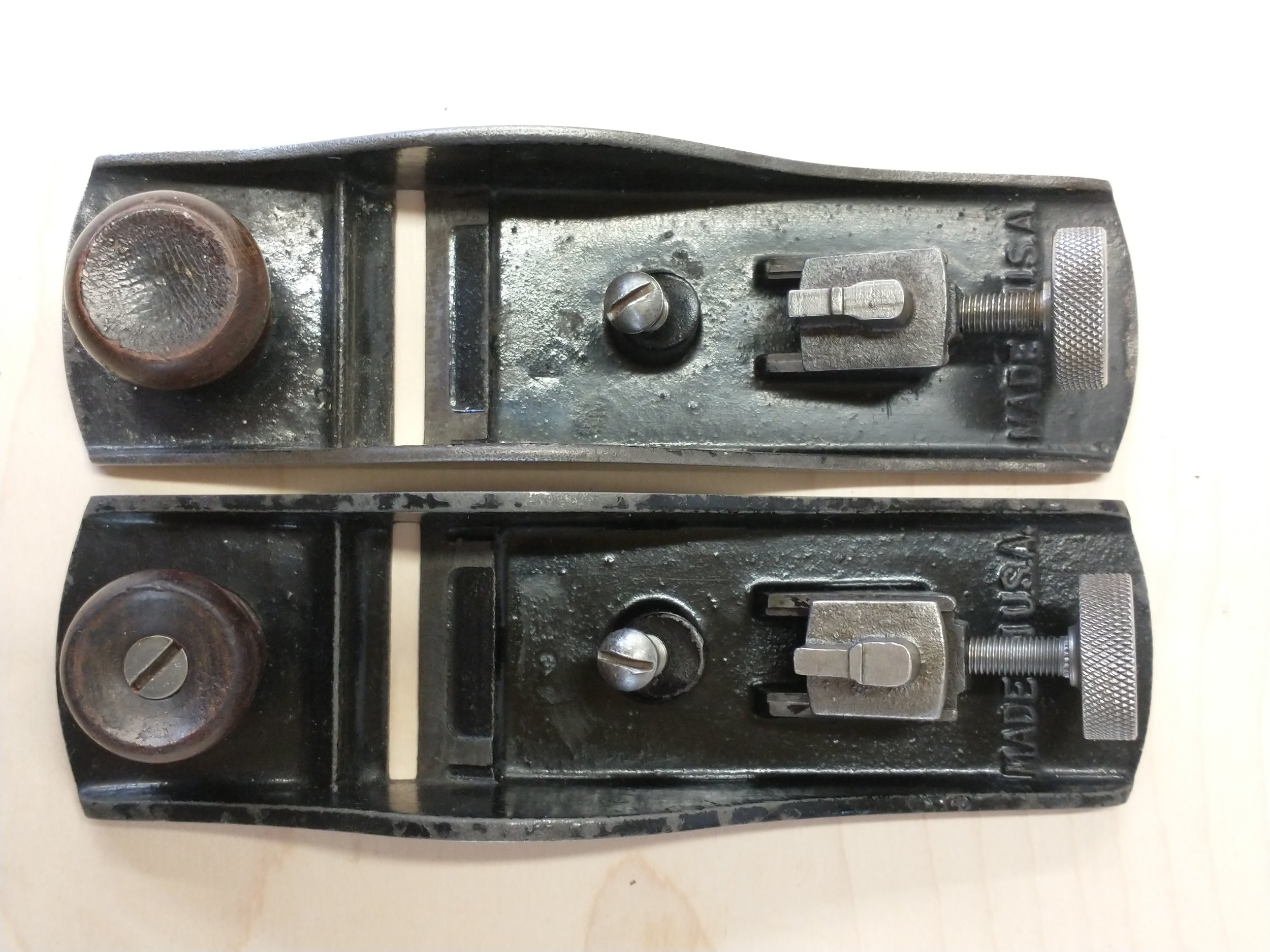
An early black cap version with a threaded knob. After 1944, the knob was secured with an external screw.

After 1942, the OEM on the iron trademark was changed from "BB" to "107.1". The cheek stamp will always have the original OEM "BB".
Dunlap 3726 Bench Plane
Equivalent to the Millers Falls No. 8
The Dunlap No. 3726 first appeared in the fall 1939 catalog. This plane has a 9-1/4” sole (including the heel tab), and a 1-3/4” iron. The one piece lever cap will have DUNLAP embossed under the lever cap screw. The hardwood stained knob and tote are secured with brass waist nuts on a double threaded 12-20 bolt from 1939 to 1941. Starting in1942, the knob and tote were secured with a one piece blued 12-20 bolt. In 1949 the waist nuts returned with a nickel finish. The plane was only sold with a smooth sole. At the time this plane was released, Millers Falls was updating its castings on the No. 8 plane by eliminating the raised tote receiver. A small number of initial release planes will have a raised tote receiver, but most planes will not have this feature.
The last catalog to carry the Dunlap No. 3726 was in the fall/winter 1956/1957.
Some of the features to look for on this plane to estimate the time of manufacturing are:
With or without a raised tote receiver.
OEM started on the iron with “BB” and changed to “107” in the early forties.
The cheek stamp will be “3DBB”. 3 is the size, D is for Dunlap, BB is the OEM.
On the initial release, the frog is black. In the early 40’s, the frog changed to red.
Prior to WWII the knob and tote were secured with brass waist nuts and a double threaded rod.
From 1942 to 1948, a single steel/blued bolt was used to secure the knob and tote.
1949-1957, knob and tote were secured with nickel waist nuts and a double threaded rod.
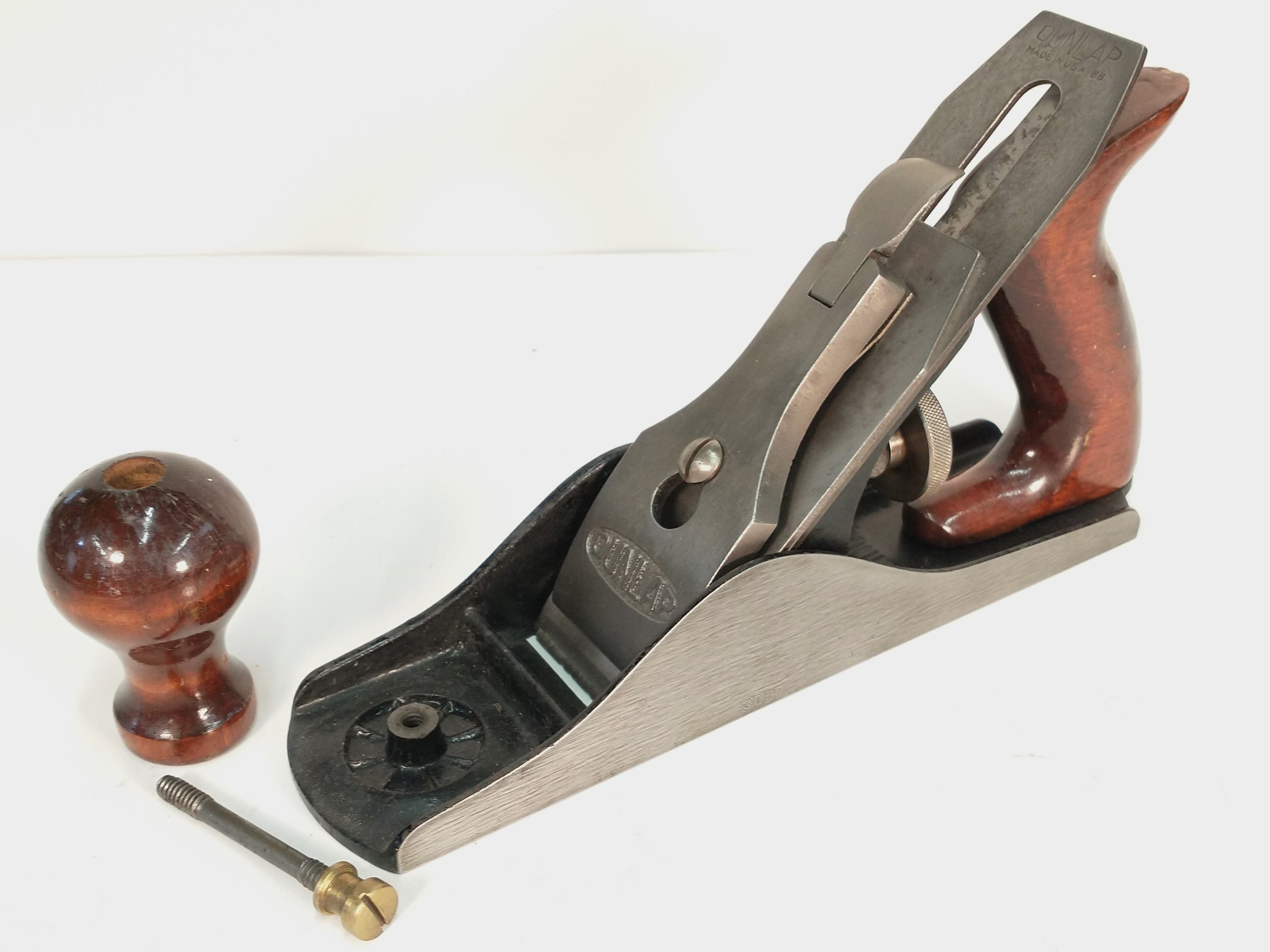
1939 to 1941 version - Brass waist nuts securing the knob and tote. "BB" OEM on the iron with a black frog.
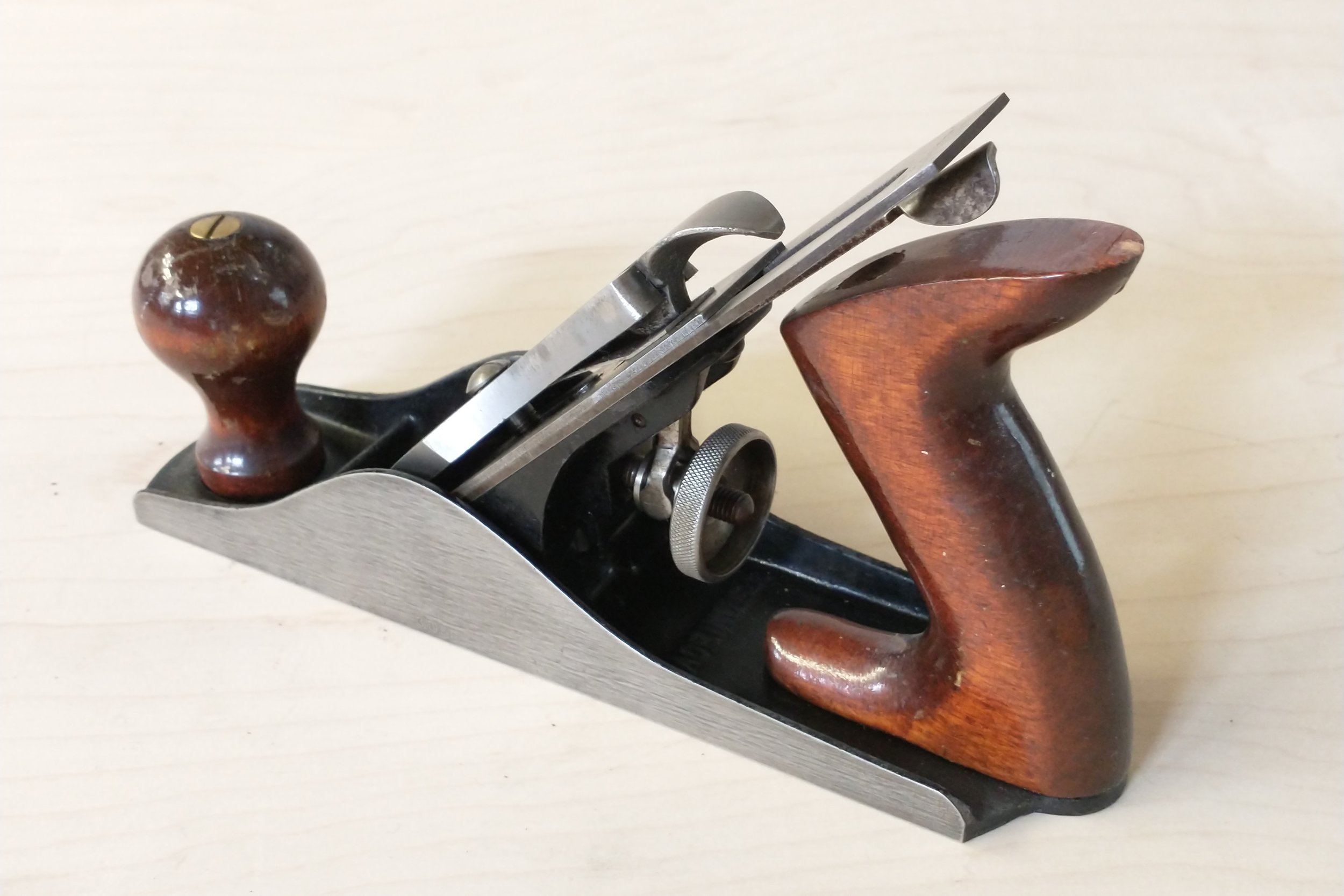
1939 to 1941 version - You can still see the wave pattern on the cheek. It is not known if all or just a few of these planes left the factory with this look.
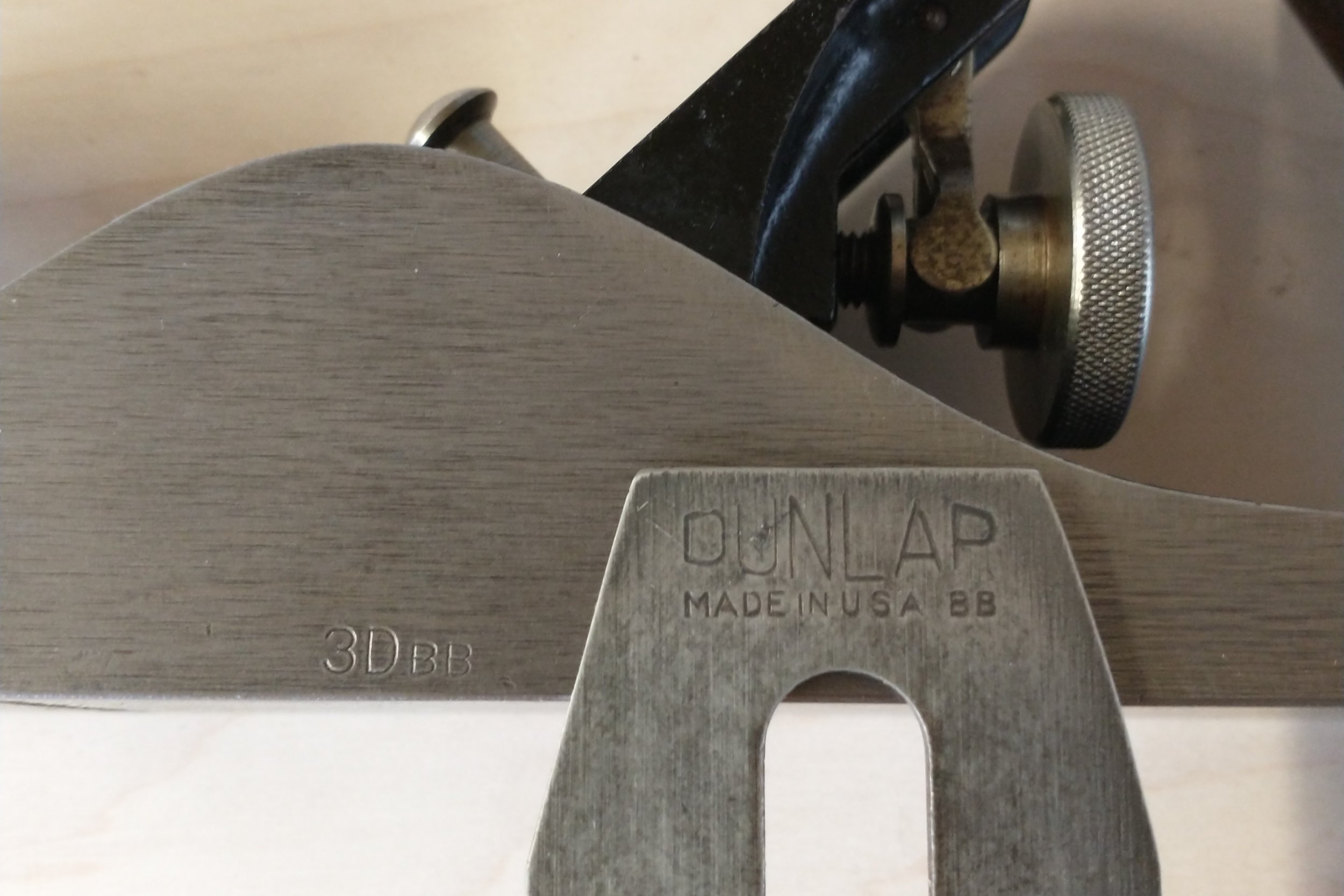
1939 to 1941 version - Millers Falls was assigned the original equipment manufacturer (OEM) of BB which started in the mid-30's until the early 40's. After the "BB", you start to see a three digit numeric code on the iron. Millers Falls had the numeric code "107".

This plane has the OEM "BB" on both the iron and the cheek.
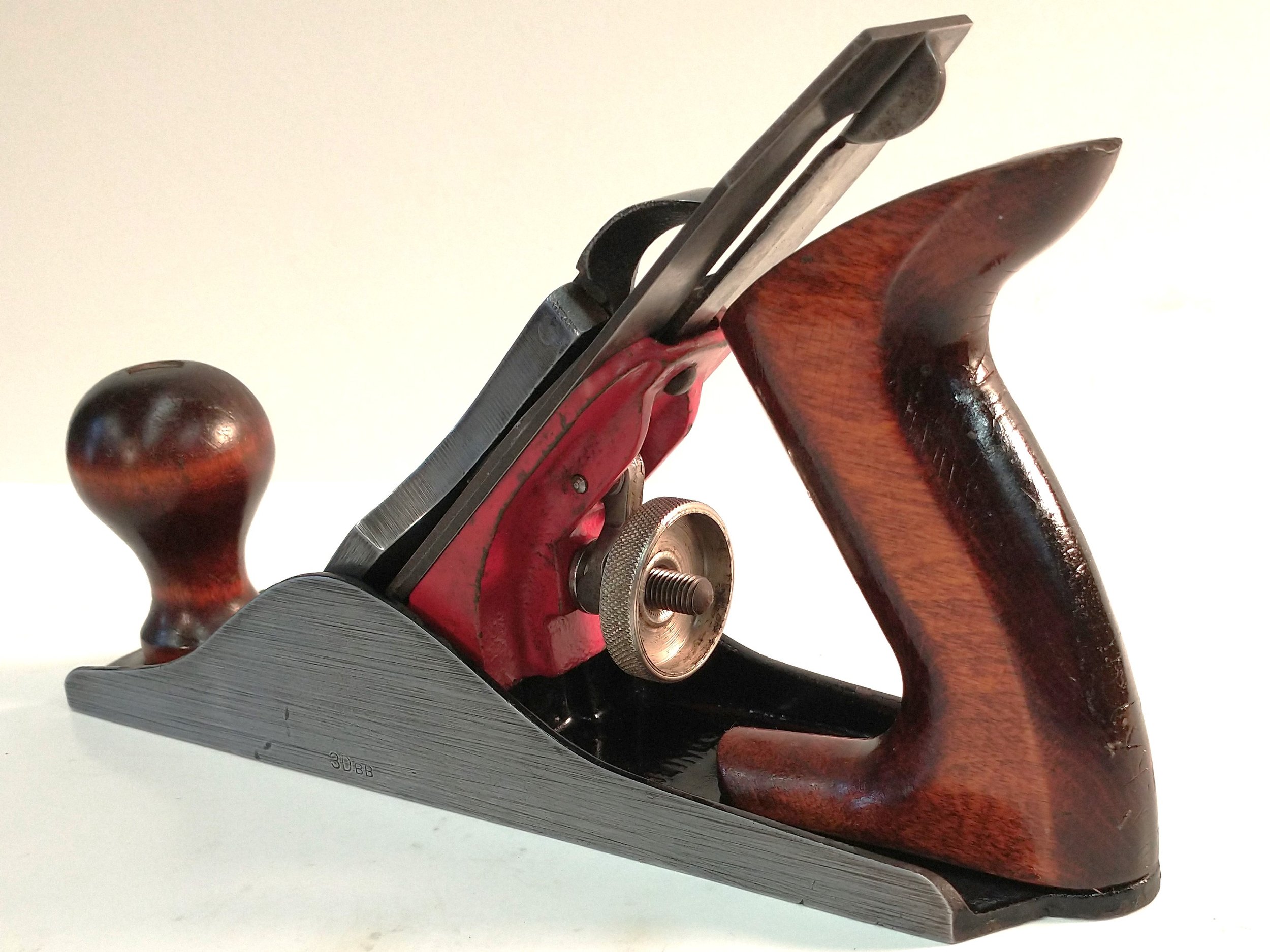
1942 to 1948 version - without taking the knob off, the 107 OEM on the iron tells you it was made in the 40's.
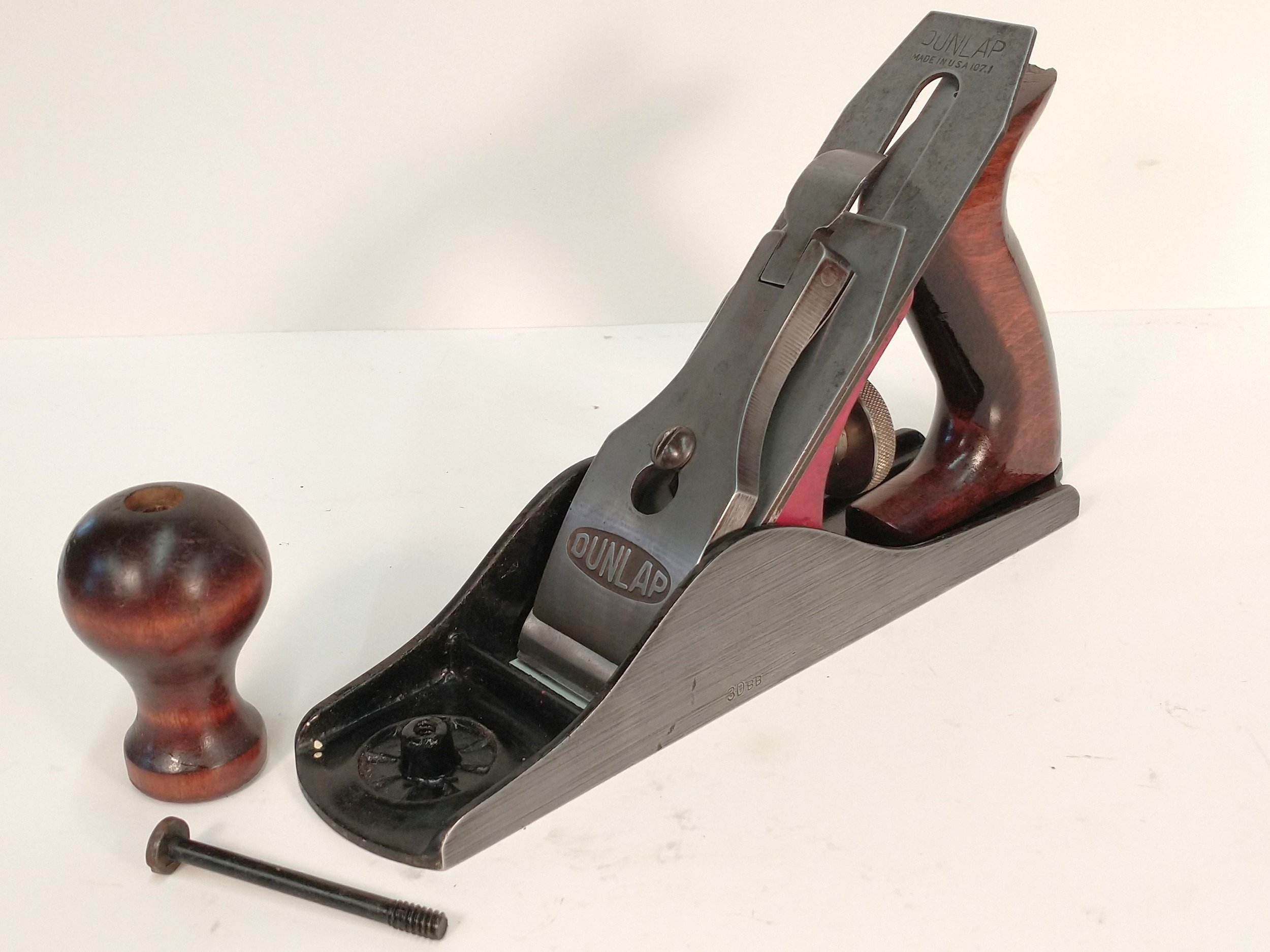
1942 to 1948 version - This plane has the OEM "BB" on the cheek and "107" on the iron. It also has steel single bolts securing the wood. Based on the bolts and the "107" OEM", this plane left the factory during the WWII years.
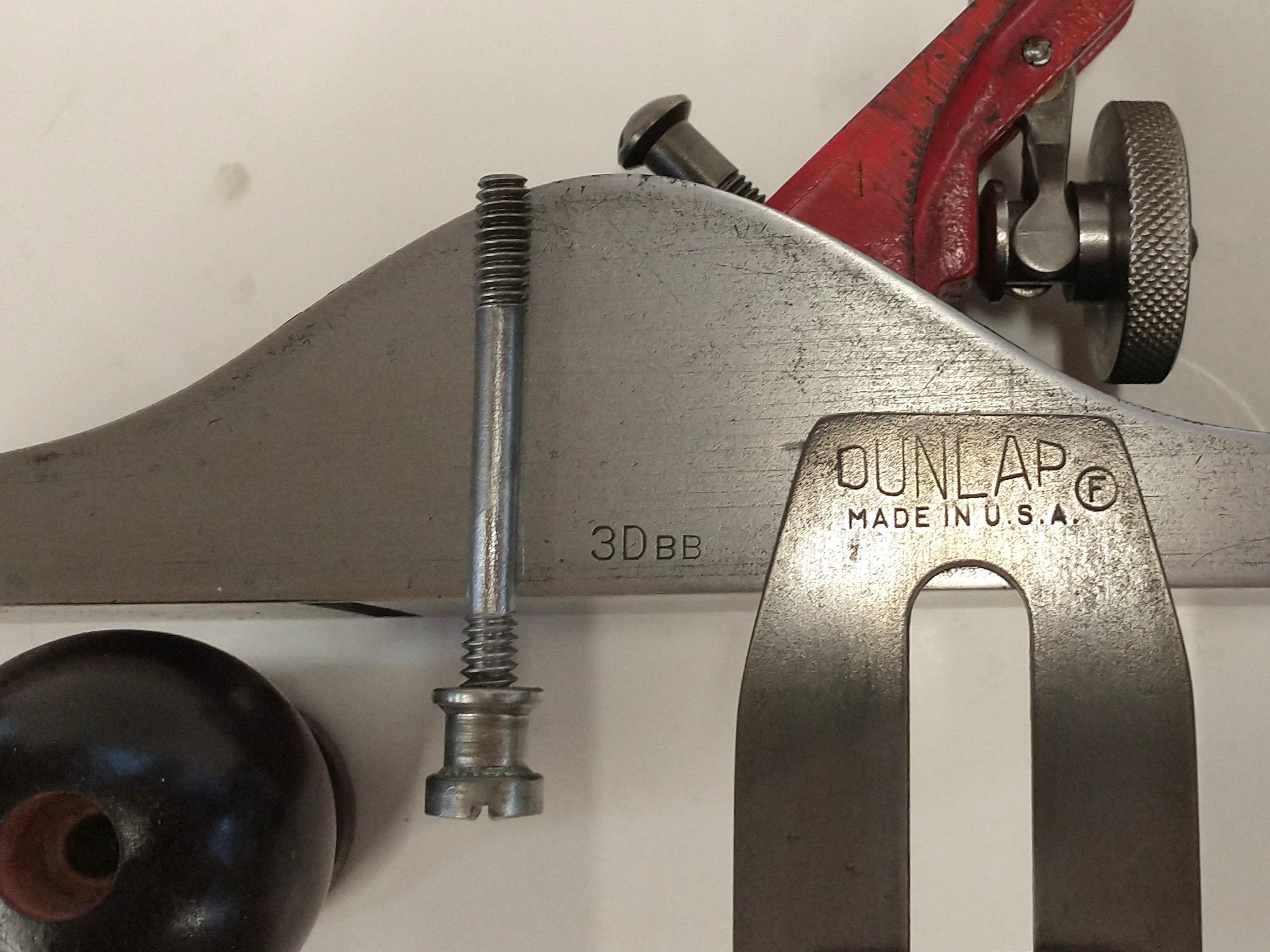
Millers Falls went back to the waist nut around 1948. This example has a nickel waist nut and the circle "F" OEM on the iron. Most irons after the mid-forties will have the "107" OEM stamp.
Dunlap 3738 Bench Plane
Equivalent to the Millers Falls No. 9
The 3738 bench planes under the Dunlap name first appeared in the fall 1939 and were sold at Sears through the fall/winter 1953/1954. Both Millers Falls and Sargent manufactured these planes. This plane has a 9-3/8” sole (including the heel tab), and a 2” iron. The one piece lever cap will have DUNLAP embossed under the lever cap screw. The hardwood stained knob and tote are secured with brass waist nuts on a double threaded 12-20 bolt. Around 1942, the bolts securing the knob and tote were changed to a one piece blued 12-20 bolt. The plane was only sold with a smooth sole. Around 1944/1945, Millers Falls changed the frog casting from 317 to 496A. The examples below show that Sears sold Millers Falls planes prior and during WWII. No example has been found of a Millers Falls No. 3738 with a 496A frog with waist nuts. (1949-1954).
Some of the features to look for on this plane to estimate the time of manufacturing are:
OEM for Millers Falls was “BB” and changed to “107” in the early 40’s on the iron.
The cheek stamp will be “4DBB”. 4 is the size, D is for Dunlap, BB is the OEM.
On the initial release, the frog is black. In the early 40’s, the frog changed to red.
The 2” frog had a casting number 317 up to 1945. After this time, the casting number was 496A.
Prior to WWII the knob and tote were secured with brass waist nuts and a double threaded rod.
From 1942 to 1948, a single steel/blued bolt was used to secure the know and tote.
From 1949 to 1954, frog would have 496A casting number and the knob and tote would be secured with a waist nut. (No 4D Millers Falls examples have been found)
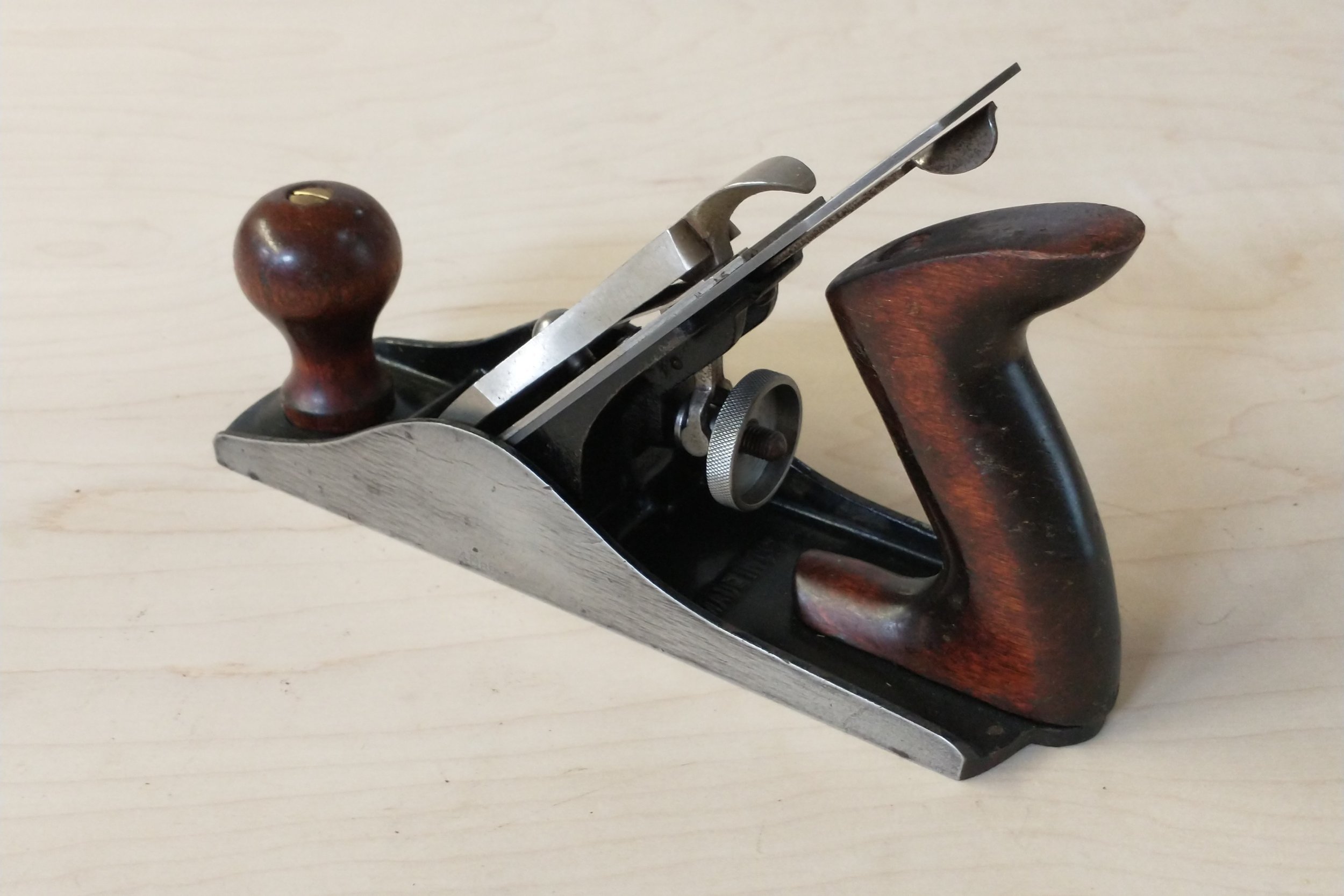
1939 through 1941 - Still see the original wave on the cheek.
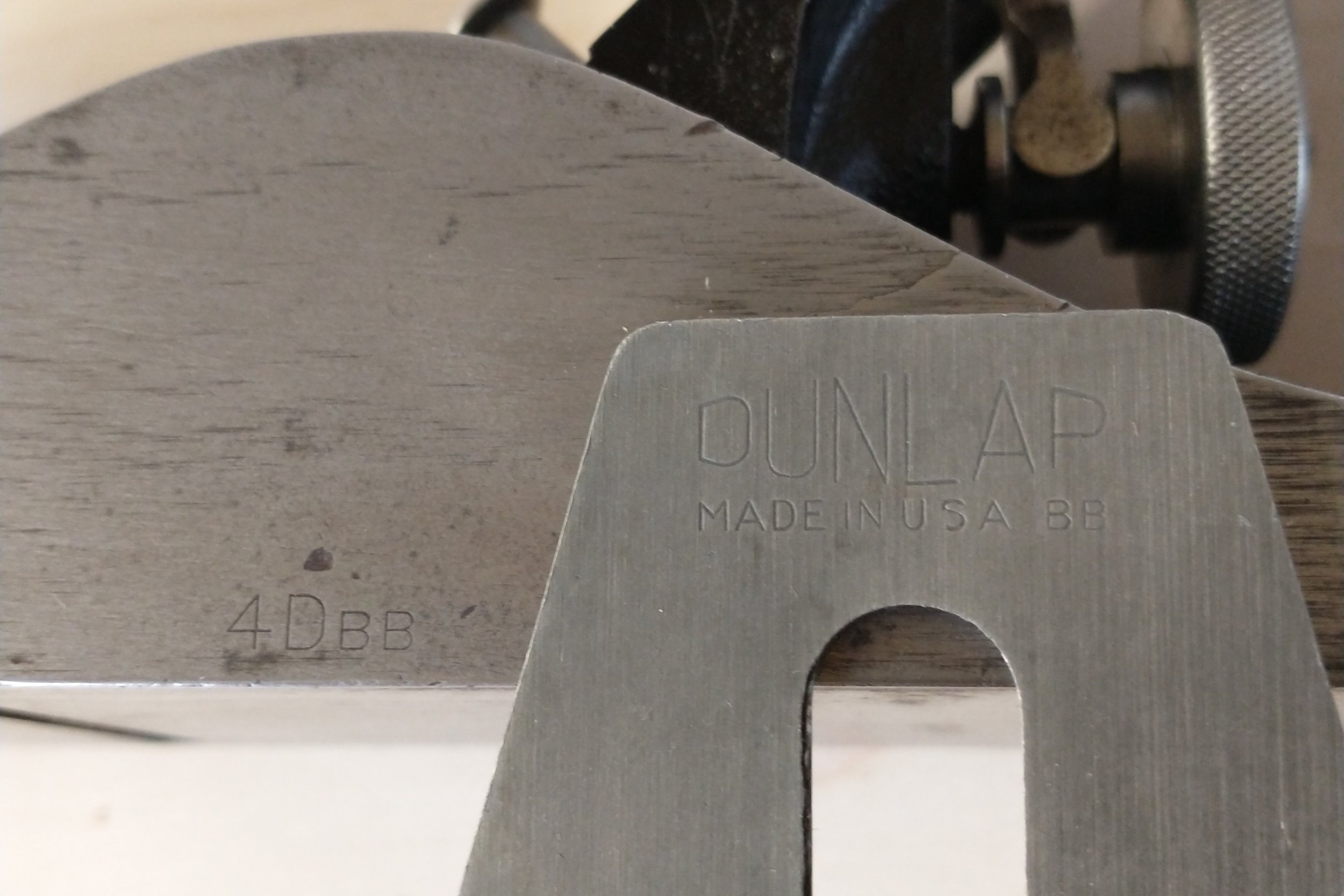
1939 through 1941 - Early version has the OEM "BB" on both the iron and cheek.

1945-1948 - One piece bolt to secure the knob and tote and a 496A casting number on the frog.
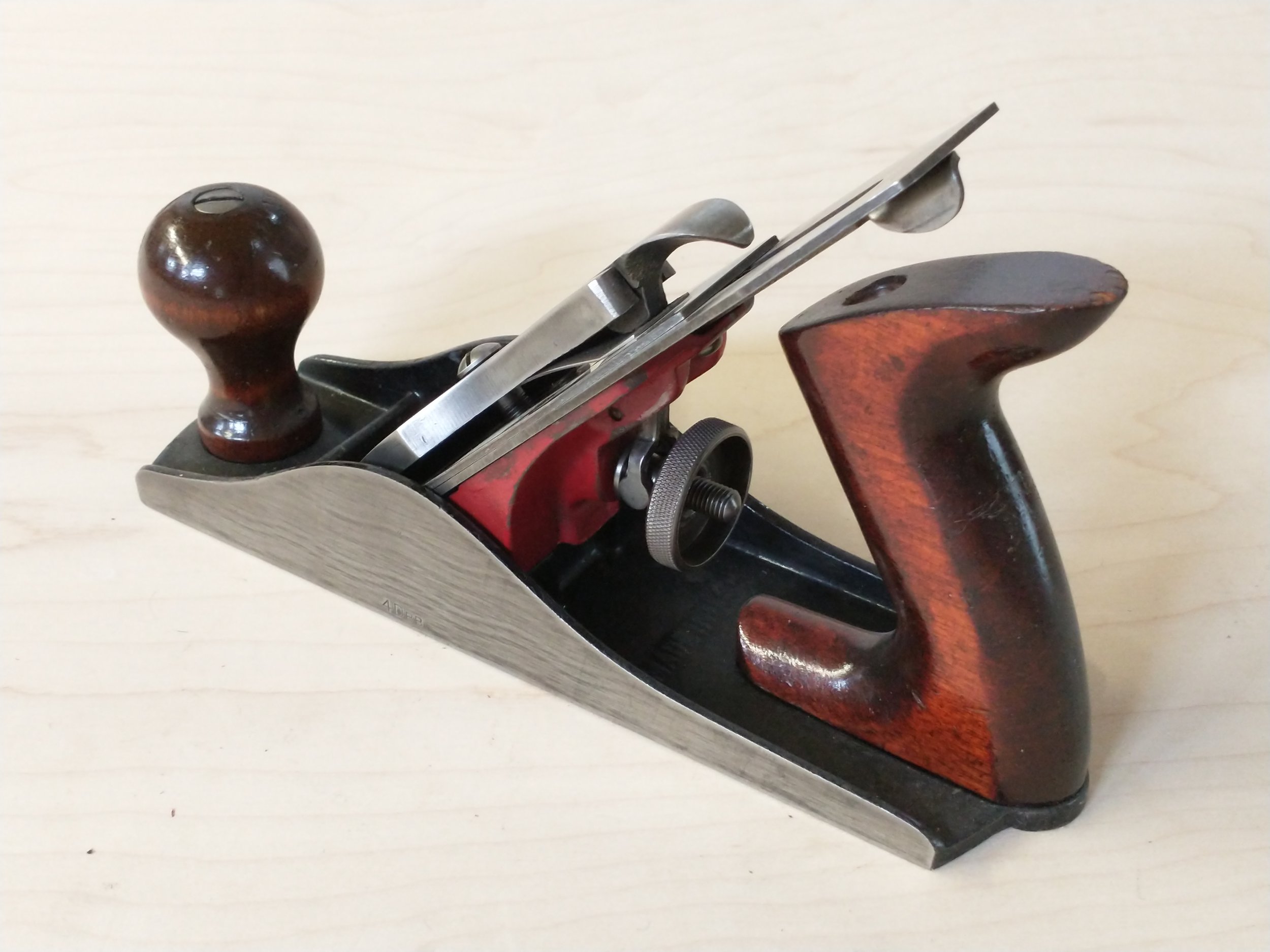
1945-1948 - From the outside it's hard to date this plane.
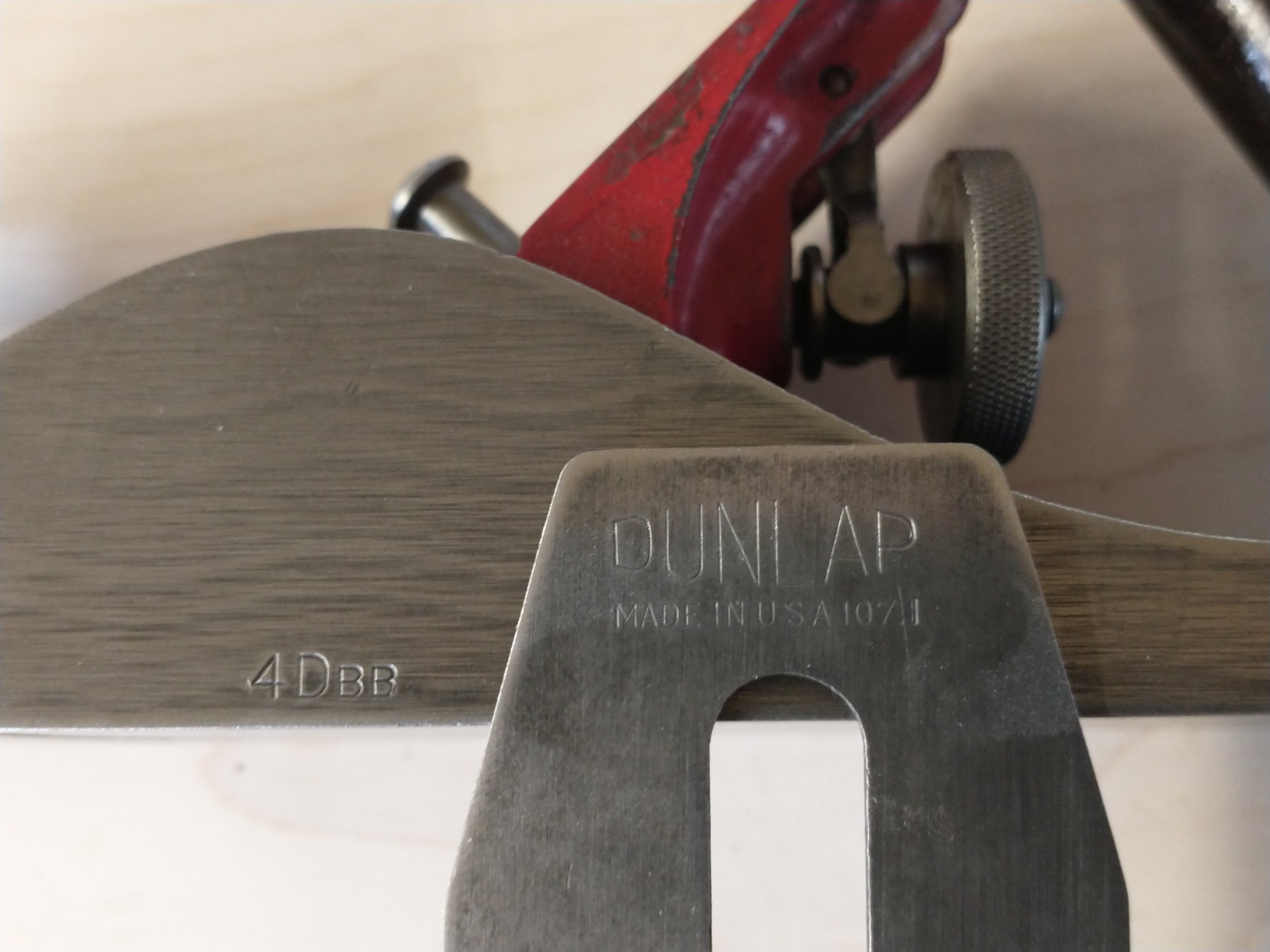
1945-1948 - The "107" and steel one-piece bolt put this plane in the forties. The frog narrows it down to the second half of the forties with the 496A casting number. You can also tell this plane has not been cleaned up when you see the "Wave".

Great to find this plane with the original box.
Dunlap 3739 Bench Plane
Equivalent to the Millers Falls No. 14
The Dunlap No. 3739 first appeared in the fall 1939 catalog. This plane has a 14” sole, and a 2” iron. The one piece lever cap will have DUNLAP embossed under the lever cap screw. The hardwood stained knob and tote are secured with brass waist nuts on a double threaded 12-20 bolt. Around 1942, the bolts securing the knob and tote were changed to a one piece blued 12-20 bolt. The plane was only sold with a smooth sole. Around 1944, Millers Falls changed the frog casting from 317 to 496A. No example has been found of a Millers Falls No. 3739 with a 496A frog with waist nuts. (1949-1957).
Some of the features to look for on this plane to estimate the time of manufacturing are:
OEM changed from BB to 107 on the iron in the early 40’s.
The cheek stamp will be “5DBB”. 5 is the size, D is for Dunlap, BB is the OEM.
On the initial release, the frog is black. In the early 40’s, the frog changed to red.
The 2” frog had a casting number 317 up to 1945. After this time, the casting number was 496A.
Prior to WWII the knob and tote were secured with brass waist nuts and a double threaded rod.
From 1942 to 1948, a single steel/blued bolt was used to secure the knob and tote.
1949 to 1957, frog would have 496A casting number and the knob and tote would be secured with a waist nut. (No 5D Millers Falls examples have been found)
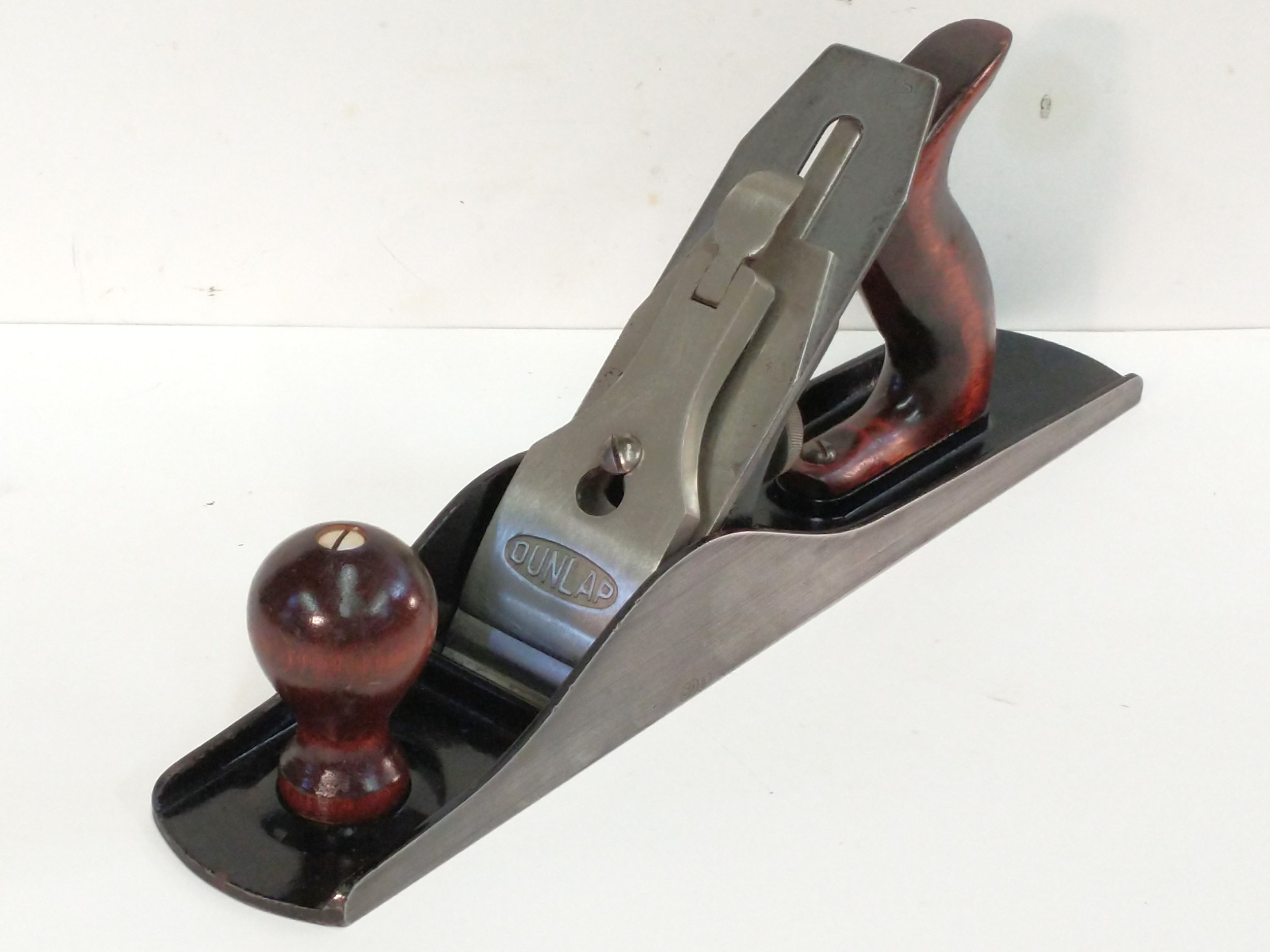
The one big feature, or lack of a feature on this plane are the missing casting gates. This plane does not have the casting gates on the bed at the toe and heel.

It was previously thought the gates were incorporated in the 1938 time frame; this plane helps define the timeline on when the casting gates were incorporated on the plane bed.

Breakdown of the No. 3739
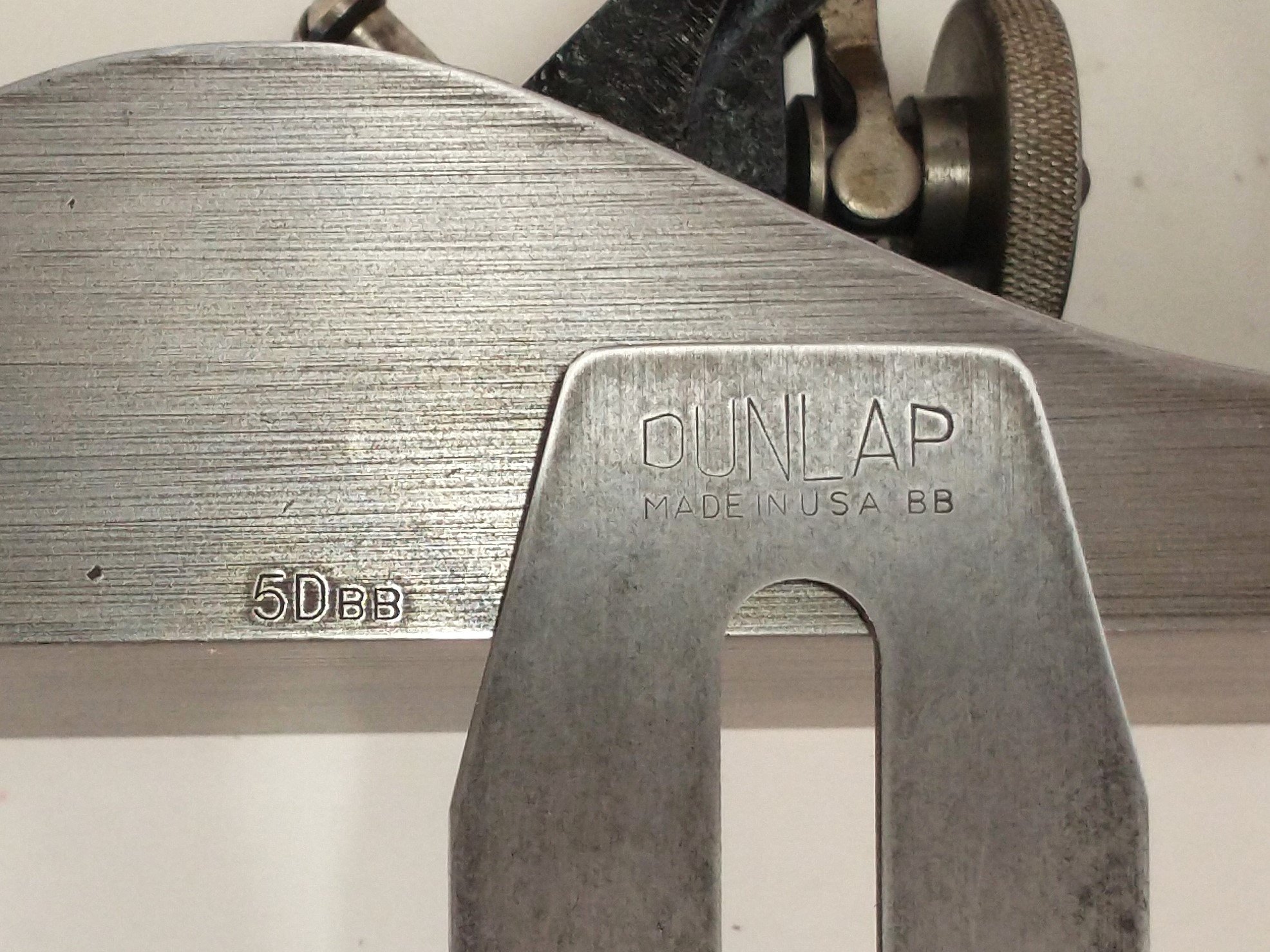
When the four Dunlap bench planes were introduced in the fall of 1939, the only stamp on the cheek was the size of the plane and the OEM. In this picture, the "5" is the Stanley size for a 14 inch body.
Dunlap 3740 Bench Plane
Equivalent to the Millers Falls No. 18
Like the other Dunlap bench planes, the No. 3740 first appeared in the fall 1939 and would be the first time a No. 6 secondary plane would be sold at Sears since the start of the premium Craftsman line in the spring 1928.
The Dunlap planes would have a one piece lever cap with the Dunlap name embossed in an oval. Millers Falls would only produce a smooth sole for the Dunlap line. Sears ended production of the No. 3740 in the summer 1943.
Some of the features to look for on this plane to estimate the time of manufacturing are:
OEM changed from BB to 107 on the iron in the early 40’s.
The cheek stamp will be “6DBB”. 6 is the size, D is for Dunlap, BB is the OEM.
On the initial release, the frog is black. In the early 40’s, the frog changed to red.
Knob and tote are stained hardwood.
Prior to WWII the knob and tote were secured with brass waist nuts and a double threaded rod.
From 1942 to 1943, a single steel/blued bolt was used to secure the knob and tote.
This No. 3740 has a brass waist nut securing the knob and tote which dates it between 1939 and 1941. Like the premium No 18, this plane has a 2-3/8” iron and an 18” sole.

